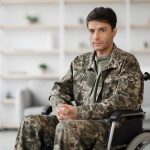The PACT Act is a new law that expands VA health care and benefits for veterans exposed to burn pits and other toxic substances. It ends the requirement that veterans prove their illness was caused by exposure to get care and benefits.
The PACT Act
On August 10, 2022, President Biden signed the Sergeant First Class (SFC) Heath Robinson Honoring our Promise to Address Comprehensive Toxics (PACT) Act of 2022 into law. This legislation helps millions of veterans exposed to toxic substances during their military service get VA health care and benefits.
The PACT Act expands VA health care eligibility to post-9/11 combat veterans. It adds 23 presumptive conditions for burn pit and toxic exposure, ending the need for veterans to prove their illness was service-connected. The law helps streamline the VA claims process so impacted veterans get faster access to VA benefits.
Impact on VA benefits
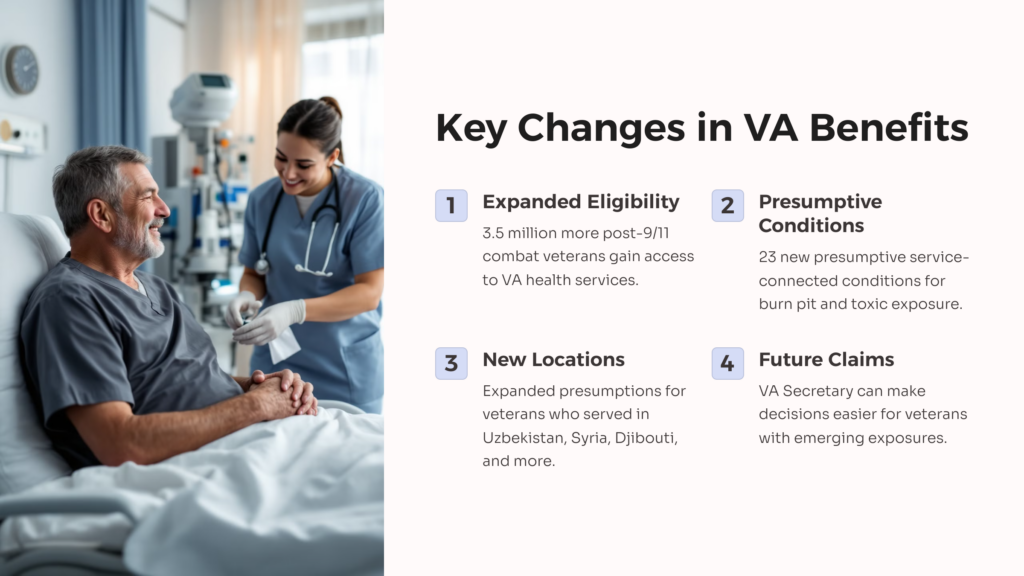
The PACT Act has an immediate impact on VA benefits for impacted veterans. Specific changes include:
- Expanded VA health care eligibility for veterans who served in combat after September 11, 2001. This gives 3.5 million more veterans access to VA health services.
- The creation of a toxic exposure screening program. All veterans enrolled in VA health care can get screened for potential toxic exposures.
- The establishment of 23 presumptive service-connected conditions for burn pit and toxic exposure. Veterans with these conditions no longer have to prove their illness was caused by military toxins.
- The expansion of presumptions to veterans who served in new locations, including Uzbekistan, Syria, Djibouti and more.
- The opening of presumptive decisions for future toxic exposure claims. This allows the VA Secretary to make it easier for veterans to get benefits for emerging exposures.
PACT Act Cutoff
While the PACT Act expands VA benefits, it does establish a cutoff restricting claims prior to September 11, 2001.
Only veterans who served in the armed forces on or after September 11, 2001 are eligible for PACT Act benefits. Veterans discharged before 9/11 are excluded unless they later served on active duty after that date.
Veterans who do not qualify based on the PACT Act date can still file claims for toxic exposure. But they will need to provide evidence linking their illness to military service. VA will review each claim on a case-by-case basis.
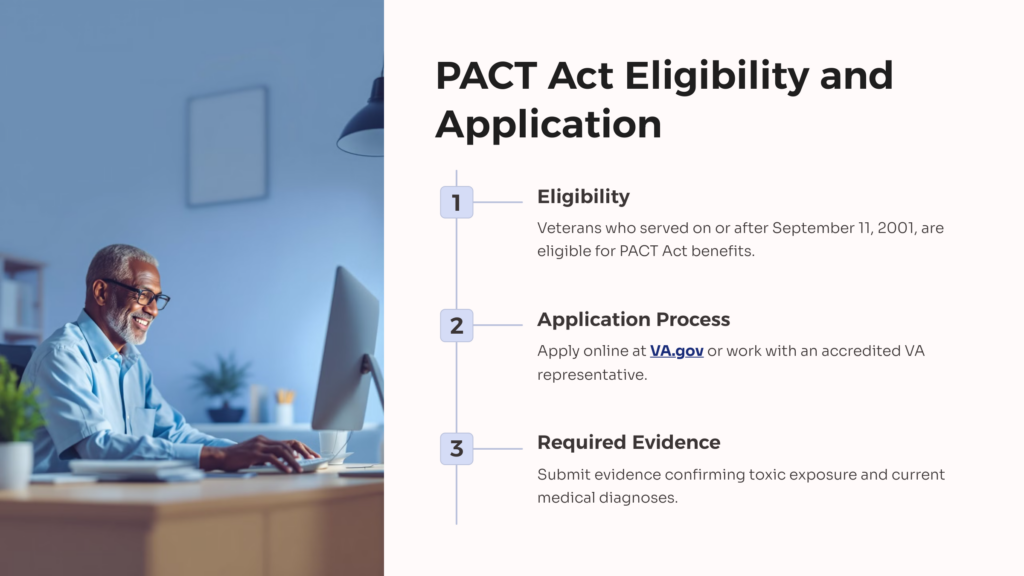
PACT Act Questions
The PACT Act makes substantial changes to VA benefits for toxic-exposed veterans. Here are some common questions:
How do I apply for PACT Act benefits?
You can work with an accredited VA representative or apply yourself online at VA.gov. You’ll need to submit evidence confirming your toxic exposure and current medical diagnoses.
When do PACT Act benefits take effect?
Most provisions take effect immediately after being signed into law on August 10, 2022. Some programs phase in over 2 years.
What conditions are covered?
There are 23 presumptive conditions including respiratory illnesses, cancers and neurological disorders. The full list is available at VA.gov.
Can I appeal a VA decision on my PACT Act claim?
Yes, veterans can appeal PACT Act claim decisions through the standard VA appeals process. Get help from a VA-accredited representative.
Who pays for my PACT Act health care?
VA covers approved PACT Act care and services for eligible veterans. There are no copays or enrollment fees.
VA Account Management
VA.gov allows veterans to access their benefits online. Create an account to manage your health, disability, education and other benefits.
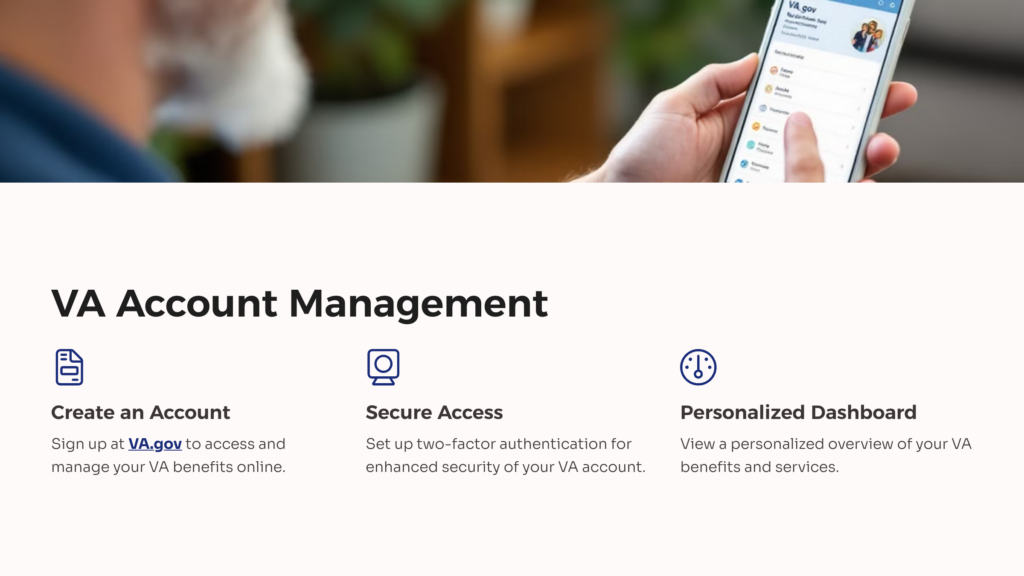
Create an Account for VA Benefits
Signing up for a VA login gives you direct access to VA services. Follow these steps:
- Go to VA.gov and click “Create an Account”
- Verify your identity using your social security number, birth date and other info
- Create a username and password
- Set up two-factor authentication for enhanced security
- Read and agree to the terms of service
Once your account is activated, you can start applying for benefits, finding VA locations and more. Your account dashboard provides a personalized overview of your VA benefits.
Account Benefits and Features
A VA.gov account unlocks tools and resources to better manage your benefits. Key features include:
Claims and Appeals – You can file disability and other claims online. Upload supporting documents from your computer or smartphone. Check the status of pending claims or appeals.
Prescriptions – Request prescription refills, track delivery and communicate with your VA pharmacy team.
Secure Messaging – Email your health care providers and get responses through secure messaging.
Appointments – Schedule and manage medical appointments at any VA facility. View past and upcoming appointments in one place.
Records – Access your VA medical records, discharge papers, payment history and other personal files. Download or print documents securely.
Notifications – Opt in to receive email or text alerts when changes occur in your VA health records, claim status, payments and more. Customize notifications.
A VA login connects you to time-saving tools all in one place. Create your free VA account today.
VA News and Updates
Stay up to date on the latest news impacting VA services and veterans benefits. Sign up to receive email or text updates direct from the VA.
Latest VA News
The VA frequently rolls out new programs, policies and partnerships relevant to veterans. Monitoring VA news helps you take advantage of new resources and benefits.
Recent VA headlines include:
- Launch of new VA Caregiver Support Line: 855-260-3274
- Expansion of Agent Orange presumptive conditions
- Changes to VA’s Comprehensive Assistance for Family Caregivers program
- Updated VA disability claim application process
- New VA Video Connect app for virtual medical visits
- Opening of three new National Veterans Burial Grounds
- Partnership with CVS to expand vaccine availability at VA facilities
Staying current on the latest news can alert you to benefit changes that may impact you and your family.
VA Year in Review
The VA publishes an annual Year in Review highlight reel. This recap covers major agency accomplishments and how services for veterans continue improving.
The 2022 Year in Review includes:
- Processing 1 million new VA health care enrollments
- Reducing veteran homelessness by 11%
- Completing a record 1.6 million disability claims
- Launching 10 new VA National Cemeteries
- Distributing over $100 billion in VA benefits to veterans and families
VA’s annual review spotlights progress made on existing initiatives. It also previews upcoming priorities for the year ahead.
Sign Up for VA Updates
Don’t wait for critical VA news – have it sent directly to your inbox. Sign up to receive email or text message updates.
The VA offers update subscriptions on:
- General VA news and information
- Changes to VA locations and services
- New research on veteran health needs
- Updates impacting your VA disability claim
- Alerts for secure message notifications
- Release of new education, career and employment resources
Manage your subscription preferences after signing up. Input your email address or mobile number to get started.
Stay well informed on resources available to you by opting into VA news alerts. Monitor your inbox for the latest.
Celebrations and Commemorations
Throughout the year, VA highlights awareness observances relevant to veterans. These events promote veteran recognition while connecting you with helpful VA services.
National VFW Day
VFW Day is celebrated annually on September 29. Established in 1968, it honors the nation’s largest and oldest major war veterans’ organization.
With over 1.5 million members, the Veterans of Foreign Wars (VFW) represents veterans worldwide. VA partners with VFW to advance policies improving veteran health, education and financial security.
On National VFW Day, take time to thank a VFW member for their service and community advocacy. Learn about VFW resources that support you as a veteran.
VFW and Hispanic Heritage Month
From September 15 to October 15, the VFW joins the nation in celebrating Hispanic Heritage Month.
This commemorates the history, culture and contributions of Hispanic Americans. VA and VFW pay special tribute to the service of Hispanic veterans and service members.
Hispanic Americans have served honorably in every U.S. conflict since the Revolutionary War. Today over 300,000 Hispanic veterans access their earned VA benefits.
During Hispanic Heritage Month, VA spotlights culturally competent programs assisting Hispanic veterans and families. This includes targeted outreach, Spanish language resources and ongoing diversity training.
Why You’re #StillServing
What does veteran service mean to you? VA’s #StillServing campaign highlights the ongoing call to serve among veterans.
Whether volunteering, supporting fellow vets or leading community projects, veterans continue serving in ways big and small. VA recognizes the diverse ways veterans give back beyond their service branch.
Throughout the year, VA profiles #StillServing veterans nationwide. Share your own story on social media using the #StillServing hashtag. Keep the ethic of service alive.
Getting Assistance
VA offers many options to find help with your veteran benefits. Get assistance through hotlines, online resources and in-person events.
Get Help Now
VA operates direct hotlines for frequently asked questions:
VA Benefits: 1-800-827-1000 for help with disability, education, vocational rehab and other benefits
VA Health Care: 877-222-8387 for new enrollments, eligibility and VA medical center info
VA GI Bill: 1-888-442-4551 for Post-9/11 GI Bill, Montgomery GI Bill and other education benefits
VA Caregivers: 1-855-260-3274 for the Program of Comprehensive Assistance for Family Caregivers
VA Mental Health: Press 1 after calling the VA hotline number for mental health support
VA Suicide Prevention: 988 then Press 1 to talk to a caring responder
Chat online at VA.gov or text 838255 for immediate support. Contact the VA to start getting answers.
Different Ways to Give
Volunteering with the VA is a meaningful way to continue serving your fellow veterans. The VA Voluntary Service (VAVS) coordinates opportunities nationwide.
Ways to give back through VAVS:
- Become a VA volunteer at your local medical center, clinic or cemetery. Serve veterans directly.
- Donate needed items to VA facilities through wish lists. Give clothing, recreation items, electronics and more.
- Organize drives for VA hospital supplies, food donations, holiday gifts and other collection campaigns in your community.
- Sponsor events and activities for veterans receiving VA care. Fundraiser donations support these morale-boosting programs.
- Use your skills to provide pro bono services to the VA. Share your talents in finance, technology, communications and more.
Visit the VAVS site to learn about current volunteer openings. Your service can make an invaluable difference in veterans’ lives.
Involvement Opportunities
Veterans have many ways to stay involved in serving the military and veteran community. Explore options to use your experience helping fellow vets.
Ways to Get Involved
Here are 10 ideas to help you find meaningful post-service involvement:
- Join a Veteran Service Organization (VSO) – VSOs advocate for veterans’ rights and provide camaraderie. Examples: American Legion, VFW, DAV, IAVA.
- Attend rallies, events and observances – Be part of the veteran community at rallies, memorial events, parades and holiday celebrations.
- Mentor a transitioning veteran – Share your lessons learned during the transition to civilian life. Provide guidance to a new vet.
- Run for elected office – Run for office to give veterans a greater political voice. Help pass legislation on veterans’ issues.
- Coach a children’s sports team – Teach kids teamwork, discipline and leadership skills through sports programs.
- Get a job assisting other vets – Work for a VSO, VA or a veteran-owned business.
- Volunteer at a VA Hospital or clinic – Brighten veterans’ days through VAVS volunteer work.
- Organize community projects – Lead a project to help vets, active duty families or honor service members.
- Become a docent at a military museum – Share military history at museums and battlefield sites.
- Join a speakers bureau – Educate community groups and students by sharing your service story.
Most Popular Ways to Get Involved
Surveys show the most common ways veterans remain involved are through:
VSO membership – VSOs give veterans a voice in policy issues while providing fellowship. The American Legion and VFW are largest.
VA volunteering – Volunteering at VA facilities lets you assist fellow vets directly through VAVS opportunities.
Community groups – Vets engage through projects like Wreaths Across America, Veterans Day events and care packages.
Mentorship – Whether through formal programs or informal advice, mentoring transitioning service members is impactful.
Political activism – Veterans take action on issues like VA reform and defense spending by lobbying and raising awareness.
Veteran-owned business – Vets hire and support other veterans through their entrepreneurial business ventures.
Choose what involvement approach best aligns with your interests and abilities. There are many ways to continue serving!
Military Service Requirements

Navigating requirements around military service can be confusing. Here is a breakdown of some key requirements for enlistment, registration and benefits.
Selective Service
The Selective Service System collects names of men ages 18-25 to be available for potential military drafts. Registration is a requirement for American men.
Steps to meet Selective Service:
- Men must register within 30 days of turning 18.
- Register online at SSS.gov or pick up a form at the post office.
- Non-citizens must register to gain eligibility for citizenship.
- Failure to register can impact ability to receive federal student loans, job training and government employment.
- Men can confirm their registration status using the SSS verification tool.
While no draft is currently in effect, federal law still requires men to register with Selective Service. Failing to register can limit government benefits.
Requirements to Enlist in the U.S. Military
Each military branch sets its own basic requirements for enlistment. However, some common criteria include:
- Being between 17 and 40 years old
- Having a high school diploma or GED
- Scoring well on the Armed Services Vocational Aptitude Battery (ASVAB) test
- Being a U.S. citizen or legal permanent resident
- Having no felony convictions
- Meeting physical, mental and moral standards
- Passing a criminal background check
- Meeting height, weight and fitness guidelines
Recruiters from the Army, Navy, Air Force, Marines and Coast Guard can explain specific requirements. Certain branches may offer exceptions or waivers in some cases.
Benefits and Pay
Compensation is an important factor when considering military service. Review military pay scales, allowances, bonuses and veterans benefits.
Military Pay and Benefits
Active duty members receive pay and allowances determined by their rank and service time. Tax-free combat and specialty pays are additional.
Base pay starts around $20,000 per year for new enlistees. Annual raises and promotions increase earnings up to over $250,000 for top generals or admirals.
The military provides extensive benefits including:
- Full medical, dental and vision coverage
- Generous retirement pensions after 20 years of service
- Free on-base housing or housing allowances
- GI Bill education assistance while serving and after
- 30 days paid vacation per year
- Tax-free grocery and uniform allowances
- Free gyms, recreational services and discounts
Veterans’ Preference and Jobs
Veterans get hiring preference for many federal jobs after military service. Benefits include:
- Eligibility for Veterans Recruitment Appointment positions with streamlined hiring
- Extra points added to civil service exam scores for most federal jobs
- Priority access to job listings only open to veterans
- Ability to bypass civil service requirements or get promoted quicker
- Protection from unjust firing once employed
Learn about veterans’ preference eligibility requirements on USAJobs. Millions of veterans work in rewarding federal careers.
Service Records and IDs
After separating from the military, get copies of your service records and register for veteran identification cards. These documents help access benefits.
Military and Veteran IDs
Two types of official IDs confirm your veteran status:
- Uniformed Services ID Card (USID) – Issued while in the military to confirm status as a service member. Retirees can obtain a USID marked “retired” after separating.
- Veterans Health Identification Card (VHIC) – Provides proof of veteran status for non-retired vets who do not have USID cards. Get one at VA health facilities.
USID and VHIC cards facilitate access to military bases, VA services, discounts and other offerings for veterans.
Carry a government-issued photo ID like a driver’s license plus military/veteran ID to fully prove identity and service history.
How to Get Copies of Military Records
View and print your own service records for free using the DoD milConnect system. Or request copies through the VA or National Archives.
- Obtain digitally – Register on milConnect to access DD214s, health records, awards citations and more.
- Request through VA – Ask the VA for a copy of discharge papers, separation documents, or VA claim records.
- Order from National Archives – Get full Official Military Personnel Files by completing a Standard Form 180.
Having personal copies of service records makes applying for benefits faster and easier. Keep copies safe since replacing lost records can be difficult.
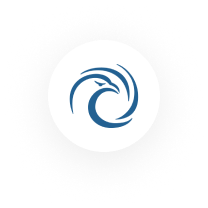 AllVeteran.com Advisors
AllVeteran.com Advisors
With expertise spanning local, state, and federal benefit programs, our team is dedicated to guiding individuals towards the perfect program tailored to their unique circumstances.

